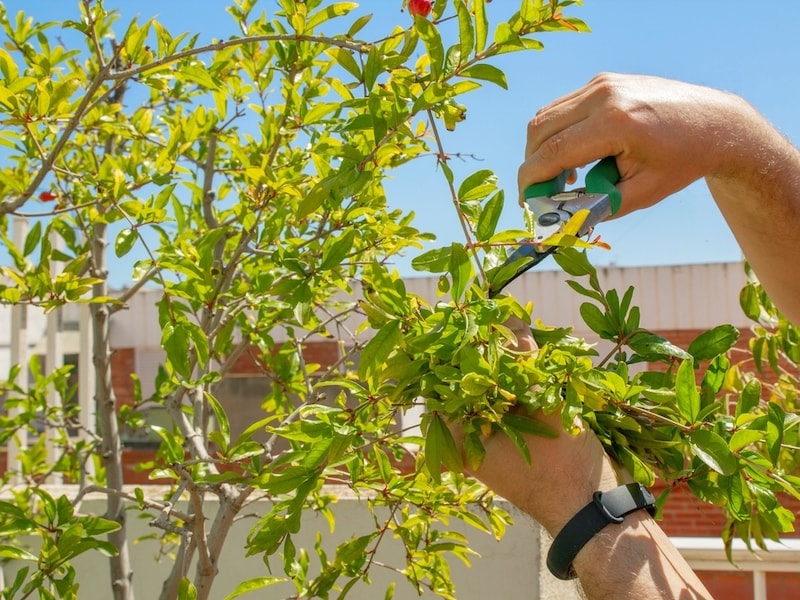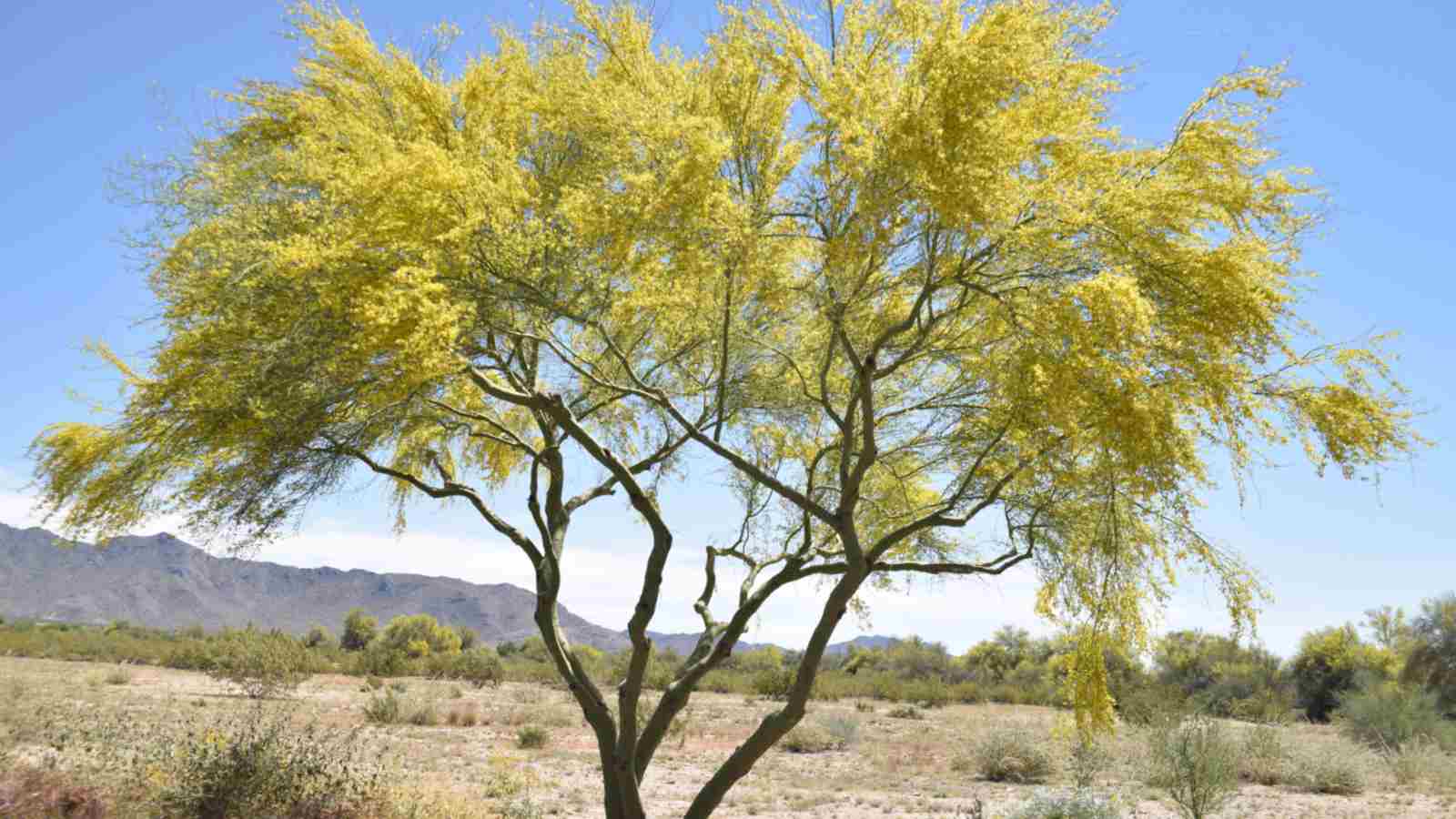Trimming a pomegranate tree is an important chore that improves the tree’s health, increases fruit production, and keeps it in shape. At Huffman Tree Services, we offer extensive information to help you obtain the best outcomes. To know about how to trim a pomegranate tree follow these complete methods.
The importance of trimming the pomegranate tree
Trimming a pomegranate tree is important for various reasons.

Regular trimming helps to eliminate dead, diseased, or damaged branches, preventing disease and pests from spreading throughout the tree. This improves general health and longevity.
Fruit Production: Pruning promotes the development of new fruiting wood, increasing the quantity and quality of fruit produced. Well-pruned plants frequently produce larger, juicier pomegranates.
Shape and Structure: Proper trimming helps the tree keep its desired shape and structure. This promotes a well-balanced canopy, increases light penetration, and improves air circulation, all of which are necessary for healthy development and fruiting.
Strength: Removing weak or crossing branches allows the tree to focus its energy on stronger branches. This produces a more strong and durable tree that can tolerate large fruit loads and harsh weather conditions.
Aesthetic Appeal: Regular trimming keeps the tree tidy and beautiful. A well-kept tree improves the visual attractiveness of your garden or orchard, adding to a more pleasant atmosphere.
Understanding the timing to trim a pomegranate tree
Timing is everything when it comes to cutting a pomegranate tree. Pruning is most effective from late winter to early spring, just before the tree begins its new growth cycle. This time enables the tree to recover quickly from cuts and promotes vigorous new growth in the subsequent season. Pruning during this time reduces the risk of cold damage and disease spreading, allowing the tree to remain healthy and productive. Avoid trimming in the autumn because it can promote new growth that is susceptible to winter frost, thus compromising the tree’s general health.
Gather the necessary tools to trim a pomegranate tree
Before you begin pruning, make sure you have the necessary tools.
Pruning shears are used for tiny branches and shoots.
Loppers are used to trim heavy branches that shears cannot reach.
Pruning Saw: For larger branches.
Gloves and Safety Goggles: To guard against thorns and debris.
Disinfectant is used to clean instruments and prevent disease spread.
Related Posts:
How to trim a pomegranate tree
Assess the tree
Inspect the tree for the following:
To stop the spread of disease, identify and mark any dead or diseased branches for removal.
Crossing or rubbing branches can damage one another, so they should be trimmed.
Remove any growth from the tree’s base or trunk.
Remove dead and diseased branches
Begin by removing any dead, damaged, or infected branches. Cut these branches back to healthy wood with clean cuts immediately above a bud or lateral branch. Use sharp equipment to ensure clean cuts, and disinfect your tools between cuts to prevent disease transmission.
Remove the suckers and water sprouts
Remove suckers (shoots that develop from the tree’s base) and water sprouts (vigorous vertical shoots that frequently emerge from the trunk or branches). Remove these suckers and water sprouts to redirect the tree’s energy towards fruit production, as they divert energy from the main tree.
Thin the canopy
Thinning is the process of eliminating entire branches and returning them to their point of origin. This procedure increases air circulation and light penetration within the canopy, lowering the risk of illness and fostering healthy development. Selectively eliminate branches that are:
Crossing and rubbing can cause wounds in the tree, making it prone to disease.
To open up the canopy, remove branches growing toward the tree’s center.
You should thin out weak or spindly branches to make room for stronger ones.
Shape the tree
Pruning down branches: Heading is the process of pruning branches down to a bud or lateral branch. This approach shapes the tree and promotes new growth. Focus on:
Maintaining an Open Center: Aim for a vase-like structure with an open center so that sunlight may reach all sections of the tree.
To maintain stability and support the weight of the fruit, balance the canopy by distributing the branches of the tree around the trunk.
Final Touches
After making the big cuts, take a step back to evaluate the tree’s overall shape and balance. Make any final adjustments by pruning any small branches or shoots that you may have missed.
Post-Trimming Care
Watering
After trimming, thoroughly water the tree to aid in its recovery from pruning stress. Continue to offer appropriate water, particularly during dry spells.
Mulching
Mulch around the tree’s base will help to retain moisture, discourage weeds, and regulate soil temperature. To prevent rot, keep the mulch a few inches away from the tree trunk.
Fertilising
Fertilize the tree with a balanced fertilizer. Follow the manufacturer’s recommendations for application rates and timing.
Monitoring
Regularly, inspect the tree for signs of pests and illnesses. Early detection and treatment can help prevent serious damage and keep the tree healthy.
Common Mistakes to Avoid
Over-Pruning
Avoid removing excessive foliage, since this might stress the tree and diminish fruit output. Aim to remove no more than 20–30% of the tree’s canopy in one season.
Incorrect timing
Avoid pruning in the autumn because it can promote new growth that is vulnerable to winter damage. For the best results, work from late winter to early spring.
Improper tools
Using dull or improper tools might result in jagged cuts that take longer to heal and are more susceptible to infections. Always prune using sharp, clean instruments.
FAQS
How much of the tree should you trim in a single season?
To avoid stressing the tree and lowering fruit output, try not to remove more than 20–30% of its canopy in a single season.
What exactly is the difference between thinning and heading?
Thinning is the process of eliminating entire branches and returning them to the main stem or a lateral branch to increase light and air circulation. Cutting down branches to form a bud or lateral branch encourages new development and shapes the tree.
How do I handle suckers and water sprouts?
Suckers and water sprouts should be removed since they drain energy from the primary tree. To keep the trees healthy and focused on fruit production, cut them back to their origins.
Conclusion
How to trim a pomegranate tree is critical for keeping it healthy, increasing fruit production, and preserving its beautiful appearance. Following the thorough techniques provided in this book will allow you to efficiently trim your tree, ensuring rapid growth and bountiful fruit. Remember to use the proper tools, prioritize safety, and prune at the right time for the greatest results. Regular trimming not only increases the tree’s productivity but also helps to create a healthier and more visually appealing garden. For those who prefer expert assistance, Huffman Tree Services is available to help with all of your tree care needs.





